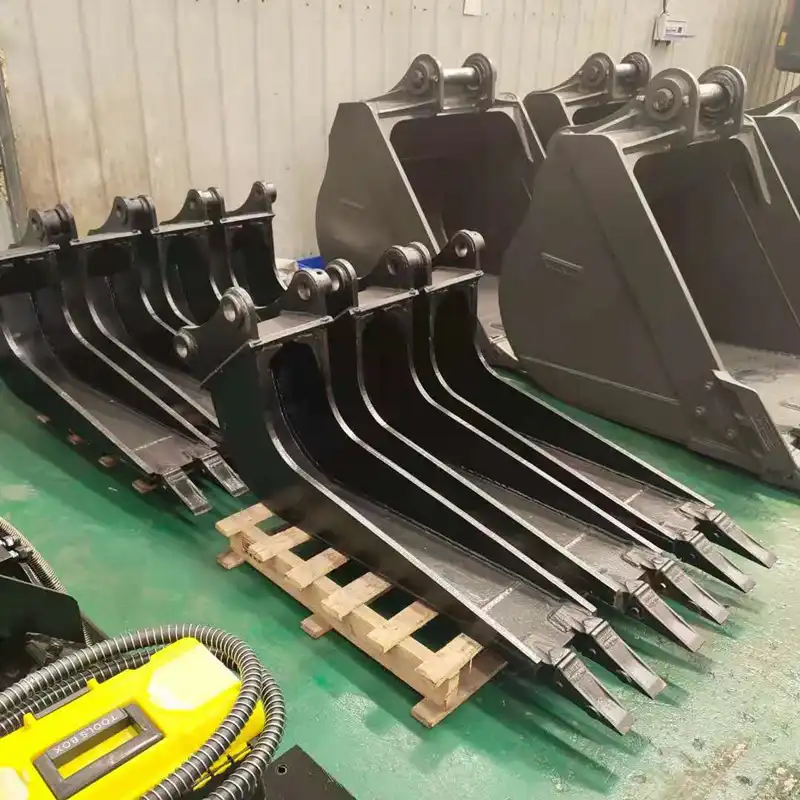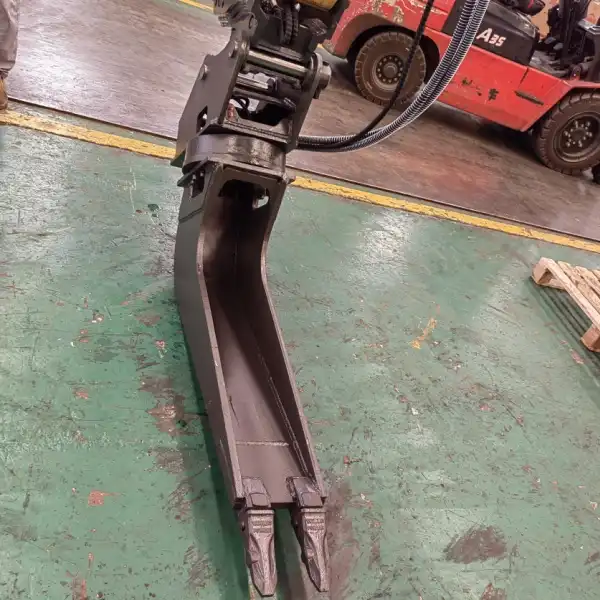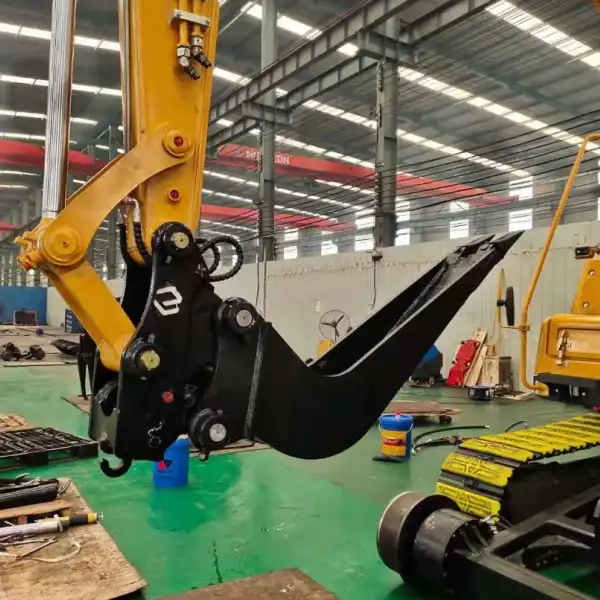What is the purpose of the excavator ballast cleaning hopper?
The primary purpose of an excavator ballast cleaning hopper centers on maintaining railway track integrity through systematic ballast purification processes. This specialized railway maintenance equipment serves multiple critical functions that directly impact track performance, safety, and operational longevity. The hopper's fundamental role involves excavating contaminated ballast material from railway beds, separating clean aggregate from debris and impurities, and redistributing purified ballast back to the track foundation. Beyond basic cleaning operations, these hoppers fulfill essential material handling requirements by efficiently transporting processed ballast, managing contaminated spoil removal, and providing temporary storage solutions during maintenance cycles. Railway operators rely on ballast cleaning hoppers to restore track drainage capabilities, eliminate vegetation growth, remove fine particles that compromise track stability, and maintain proper ballast angularity necessary for effective load distribution. The equipment's purpose extends to cost-effective track maintenance by reducing the need for complete ballast replacement while extending service life through targeted cleaning interventions that preserve railway infrastructure investments.

Ballast Cleaning
The ballast cleaning function represents the cornerstone purpose of excavator-mounted hoppers in railway maintenance operations. Through sophisticated screening mechanisms, these specialized attachments tackle the persistent challenge of ballast contamination that naturally occurs over time in railway environments.
Debris Separation and Purification
Railway ballast accumulates various contaminants including fine particles, organic matter, and foreign debris that compromise track performance over time. The excavator ballast cleaning hopper addresses this challenge through mechanical separation processes that distinguish between valuable ballast stones and unwanted materials. Ballast screening machines are equipped to effectively remove contaminants from the ballast. These contaminants, such as debris, dirt, and vegetation, are efficiently separated and disposed of aside from the track or into designated rolling stock. The screening mechanism utilizes calibrated mesh sizes that allow clean ballast to pass through while retaining oversized debris and filtering out fine particles that reduce drainage effectiveness.
Angularity Preservation and Stone Quality
Maintaining ballast angularity becomes crucial for proper track support and load distribution capabilities. Over time, ballast becomes worn, and loses its angularity, becoming rounded. The cleaning hopper's purpose includes preserving the geometric characteristics of quality ballast stones while removing only the contaminated material that threatens track stability. The separation process distinguishes between stones with adequate angular properties and those requiring replacement, allowing railway maintenance teams to maximize the utilization of existing ballast resources.
Track Drainage Enhancement
Effective ballast cleaning directly impacts railway drainage performance by removing fine particles that clog the void spaces between ballast stones. The hopper's cleaning action restores the natural drainage characteristics of the ballast bed, preventing water accumulation that can lead to track instability, frost damage, and premature infrastructure deterioration. Clean ballast provides superior drainage compared to contaminated material, reducing maintenance frequency and extending track service life through improved moisture management.
Material Handling
The material handling purpose of ballast cleaning hoppers encompasses efficient movement, processing, and distribution of railway ballast throughout maintenance operations. This functionality streamlines maintenance workflows while ensuring optimal resource utilization during track rehabilitation projects.
Excavation and Collection Efficiency
The hopper's design optimizes ballast excavation processes by incorporating precise collection mechanisms that target specific track sections requiring maintenance. The ballast material is excavated, the material is screened to separate ballast from spoil, the cleaned ballast is returned to the track and the spoil is taken away. This systematic approach ensures comprehensive ballast collection while minimizing disruption to adjacent track infrastructure. The excavation process utilizes the excavator's hydraulic power to efficiently gather contaminated material from beneath railway sleepers and surrounding areas.
Spoil Management and Disposal
Effective spoil management represents a critical aspect of the hopper's material handling purpose. Contaminated material removed during the cleaning process requires proper collection, transport, and disposal to prevent recontamination of cleaned ballast. The hopper incorporates dedicated spoil collection systems that separate waste material from clean ballast, directing contaminated debris to appropriate disposal locations away from the active track zone. This spoil management capability reduces cleanup time and ensures environmental compliance during maintenance operations.
Clean Ballast Distribution
The redistribution of cleaned ballast serves as a fundamental material handling function that completes the maintenance cycle. The reclaimed ballast is distributed back to the shoulder area of the ballast profile. The hopper's discharge mechanisms provide controlled placement of cleaned material, allowing operators to achieve proper ballast distribution patterns that support track geometry requirements. This distribution capability ensures optimal ballast density and coverage while maintaining proper track profile specifications.

Storage
The storage purpose of excavator ballast cleaning hoppers provides essential temporary material management capabilities that support efficient railway maintenance operations. This functionality addresses the practical requirements of ballast processing workflows while maintaining material quality during maintenance cycles.
Temporary Material Retention
The hopper's storage capacity allows temporary retention of ballast material during processing operations, enabling continuous workflow maintenance without interruption. The material conveyor and hopper units serve both to supply material and to transport the excavated material away without using the adjacent track. This temporary storage capability prevents material loss during screening operations while providing operators with flexibility to adjust processing rates based on track conditions and maintenance requirements.
Batch Processing Capabilities
Storage functionality enables efficient batch processing of ballast material, allowing maintenance teams to process larger quantities of contaminated ballast in systematic cycles. The hopper's capacity accommodates varying volumes of material based on track section requirements and contamination levels encountered during maintenance operations. This batch processing approach optimizes equipment utilization while ensuring consistent cleaning quality across extended track sections.
Material Quality Preservation
The storage design protects processed ballast from recontamination during maintenance operations through controlled containment systems. Clean ballast stored within the hopper remains separated from contaminated material and environmental factors that could compromise cleaning results. This quality preservation function ensures that processed ballast maintains its improved characteristics until redistribution, maximizing the effectiveness of the cleaning operation and extending the service life of maintenance interventions.

FAQ
①What makes excavator ballast cleaning hoppers essential for railway maintenance?
Excavator ballast cleaning hoppers provide cost-effective track maintenance by separating clean ballast from contaminated material, extending track service life while reducing the need for complete ballast replacement.
②How do ballast cleaning hoppers improve track drainage?
The cleaning process removes fine particles and debris that clog void spaces between ballast stones, restoring natural drainage characteristics that prevent water accumulation and track instability.
③What types of contamination can ballast cleaning hoppers remove?
These hoppers effectively remove dirt, vegetation, fine particles, organic matter, and foreign debris that accumulate in railway ballast over time through regular train operations.
④Can ballast cleaning hoppers work with different excavator models?
Modern ballast cleaning hoppers feature universal quick-coupler mounting systems that accommodate various excavator models, particularly rail-wheel and dual-mode machines.
⑤How does the screening process preserve ballast quality?
The screening mechanism uses calibrated mesh sizes to separate clean angular ballast from contaminated material, preserving the geometric characteristics necessary for proper track support.
Experience Superior Railway Maintenance with TianNuo's Advanced Solutions
TianNuo's excavator ballast cleaning hopper delivers unmatched performance in railway maintenance applications through innovative engineering and robust construction. Our comprehensive solution addresses the complex challenges of ballast cleaning, material handling, and storage with precision-engineered equipment designed for demanding railway environments.
Our ballast cleaning hoppers come in two distinct configurations - rotary and mechanical - each optimized for specific maintenance requirements. The rotary design excels in continuous cleaning operations, while the mechanical version provides superior control for precision work between sleepers. Both types efficiently clean ballast at the bottom of steel rail slabs, ensuring comprehensive contamination removal throughout the track structure.
Built with wear-resistant steel and reinforced structural components, TianNuo hoppers withstand the rigorous demands of railway maintenance operations. The quick-coupler mounting system ensures seamless integration with most rail excavators, while adjustable ballast output sizing accommodates varying project specifications and contamination levels.
Our advanced discharge mechanisms offer both hydraulic and gravity-fed operation with optional gate control systems that provide precise material placement. The removable mesh design and rotating shaft configuration allow easy maintenance access while ensuring consistent screening performance throughout extended maintenance cycles.
TianNuo's hydraulic control systems integrate seamlessly with excavator power sources, optimizing operational efficiency while minimizing fuel consumption. The equipment's compatibility with rail-wheel excavators and dual-mode machines provides flexibility for various maintenance applications and track access requirements.
We understand that every railway maintenance project presents unique challenges, which is why TianNuo offers comprehensive custom design support. Our engineering team works closely with clients to develop specialized solutions that meet specific operational requirements, track configurations, and performance objectives.
The anti-corrosion and weatherproof coating treatment protects your investment in harsh operating environments, ensuring long-term reliability and minimal maintenance requirements. This surface treatment extends equipment life while maintaining optimal performance standards throughout demanding railway maintenance operations.
TianNuo Construction Machinery Co., Ltd combines decades of manufacturing expertise with cutting-edge technology to deliver railway maintenance solutions that exceed industry standards. Our commitment to quality, innovation, and customer satisfaction positions us as the preferred partner for railway maintenance professionals worldwide.
Ready to enhance your railway maintenance capabilities with industry-leading ballast cleaning hopper technology? Our technical specialists are prepared to discuss your specific requirements and demonstrate how TianNuo's innovative solutions can transform your maintenance operations. Contact us today to explore our comprehensive range of railway maintenance equipment and discover the TianNuo advantage: arm@stnd-machinery.com.
References
- Railway Track Engineering and Maintenance: Advanced Ballast Cleaning Technologies for Modern Rail Systems, 2024
- International Railway Engineering Journal: Excavator-Mounted Ballast Processing Equipment in Track Maintenance, Volume 52, 2023
- Railway Infrastructure Management: Material Handling Systems for Ballast Cleaning Operations, 2024
- Modern Railway Maintenance Equipment: Hydraulic Screening Systems and Storage Solutions, 2023
- Railway Construction and Maintenance Technology: Integrated Ballast Cleaning and Material Management Systems, 2024
About Author: Arm
Arm is a leading expert in the field of specialized construction and railway maintenance equipment, working at Tiannuo Company. Tiannuo specializes in manufacturing a wide range of products, including railway maintenance equipment like railway sleeper changing machines and screening machines, excavator modification equipment such as excavator lifting cabs, various engineering arms for excavators, excavator accessories like digging buckets, and engineering vehicle auxiliary equipment like loader buckets.

